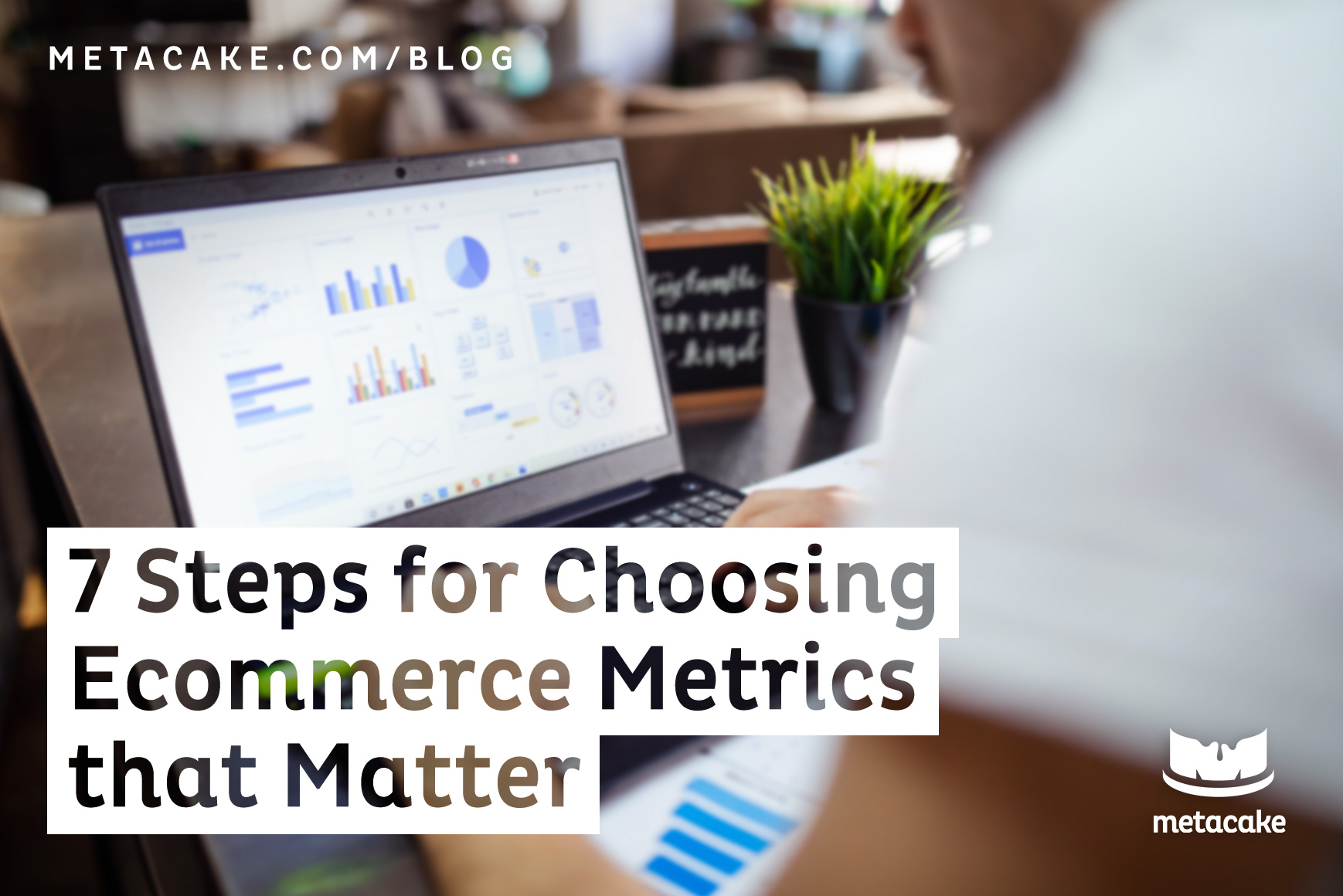
7 Steps for Choosing Ecommerce Metrics that Matter
If you run an ecommerce business or work for one, you know that there is no shortage of data to watch. Stats, analytics, metrics, and dashboards are all readily available in today’s ecommerce world. And these numbers are important if you are going to run a data-driven company.
However, there are often problems with the way most ecommerce brands track metrics. For one thing, the data they’re watching may not be accurate. Secondly, people often focus on the wrong metrics, or they are just not sure which metrics are important and which they should ignore. This leads to distracted leaders and thus companies meander through each year without hitting the right goals.
Sound familiar? What these businesses (and you) need is an understanding of what metrics matter to you in your business based on your particular role in the company and what goals the company has set. You must ignore everything else.
We often see CEOs and CMOs caught up in reporting that leads them down a long path of focusing on the wrong things. Let’s learn how to avoid that!
In this post, we’re going to walk through a 7-step process you can use to choose the correct metrics that matter for your business based on your role and the goal you’re trying to achieve. This will help clarify and simplify your day-to-day so that you can focus your time on actions that matter and actually get you results.
Two Important Mindset Shifts
Before we get into this 7-step process for choosing metrics that matter, there are two mindset shifts that need to take place.
The first is realizing that the metrics that you “should” care about can actually be different for every business. There are some basic health metrics that every brand pays attention to, but the metrics that really matter to you are dependent on:
- Your unique business
- Your brand’s short and long term goals
- The role you play in achieving that goal (because it’s likely that each role in the business is responsible for improving different metrics to help achieve the goals)
The second mindset shift when choosing metrics that matter is to not start with the data. That seems counterintuitive and almost backwards, but you’ll see why once we dive into the 7 steps below.
The Two Types of Metrics that Matter
Another thing to keep in mind when it comes to tracking data is that there are two types of metrics that matter.
The first is what we call a health metric. These are data points that indicate the basic health of the business, similar to a human’s heart rate or blood pressure. For an ecommerce business, health metrics might include revenue, profit margin, AOV, cost per acquisition, etc. While these metrics are helpful for gauging the overall wellness of your business, they aren’t always going to be the metrics that will move the needle to help achieve your unique goals.
The second type is a goal metric. Sticking with the human health analogy, human goals could include losing X pounds or achieving a certain race time on your next marathon. What you use to gauge your progress toward those goals is very different from the basic health metrics. It also varies based on the goal. If you’re trying to lose weight, watching your heart rate won’t help. Instead, you will look at pounds lost per week along with body fat percentage. If you’re training for a marathon, you might measure how many miles you run each day and how quickly you’re able to improve your time. In a business, you’ll have to identify and watch micro-level metrics in order to progress toward your goals. This is where people often get off track. In fact, we find they rarely measure goal metrics, or set ecommerce goals at all.
7 Steps for Choosing Metrics that Matter to Your Business
Now that we understand the difference between health-based and goal-based metrics, let’s walk through the 7 steps for choosing metrics that actually matter to your business.
1. Never Start with Data
Put those dashboards away (just for now)! You might be tempted to start diving into Shopify or Google Analytics data but doing that at the beginning will only make things complicated. Tuck those away for now and move on to step 2.
2. Start with a Goal
Your goal will dictate which metrics you choose to focus on because you’ll want to choose metrics that indicate real progress toward those goals.
You will likely need to set both short-term and long-term goals, which will have different metrics that indicate progress or success. A long-term goal for an ecommerce business could be to build a worldwide brand, a brand that matters 50 years from now, or a brand that could be sold in five years. Short-term, you might want to reach $1 million in sales, double your revenue in two years, or increase your net profit from $X to $Y in 1 year.
Action Item: List 1-3 long-term and short-term goals for your business. For each, be very specific, define a time frame for achieving the goal, and determine how you will measure the achievement or completion of the goal.
3. Identify Your Role in Achieving the Goal
The CEO, ecommerce director, marketing manager, and others all have roles in achieving business goals, but those roles are different. Each person cares about a different element of the scoreboard day to day. That is why you’ll need to identify not only what metrics matter in terms of your goal, but also what metrics matter in relation to your role and what you’ll work on.
Action item: For each goal listed in Step 2, list the role you play in achieving that goal. Then list the actions you will take to hit the goal along with the desired results.
4. Decide on Your Scoreboard
Next, you’ll need to translate your actions into indicators that will help you gauge the progress and completion of your role in the goal. This step is still not about digging into the data (yet). Don’t worry about how you will track these data points. The goal here is to determine what numbers you can use to be your measuring stick. For example, if you are a marketing manager and the goal is to increase profit, decreasing the cost per acquisition would be one way to gauge progress toward the goal.
Action item: Determine what specific ways you will measure the progress of your actions in achieving that goal, using data points. Pick 1-5 data points, but don’t worry about how you will track those yet.
5. Track the Data
At this point, you will have your goals and a list of the metrics that you need to watch to measure your progress. Now it’s time to determine how you will track those metrics.
Tracking will most likely happen in Google Analytics, but there are other analytics tools to monitor what G.A. cannot track. Other metrics may need to be manually calculated based on data you gather in G.A, and that is perfectly okay. Don’t limit yourself to only what analytics tools give you.
For example, we have talked before about the ad spend to revenue ratio. This doesn’t exist anywhere, so it needs to be manually calculated. It’s worth taking the time to calculate because that ratio is needed to be able to steer large, complicated marketing budgets.
Action Item: For each metric that matters to you, identify where you will track it. You may already know where to find it in Google Analytics, or you might need to bring in an expert. Whatever you do, make sure it’s being tracked accurately.
6. Create Your Dashboard
The next step is to create your dashboard. It doesn’t have to be complex or fancy; a simple spreadsheet will work. In fact, we actually recommend starting with a manual spreadsheet. This will force you to focus only on the metrics you already decided matter to your business and its goals. It will also give you time and space to validate those metrics before you put effort into building them into a dashboard.
Action Item: Open Google Sheets and create a spreadsheet to monitor the metrics you chose, either daily or weekly. Doing this manually will help make sure you don’t pick too many metrics as well as help make sure you’re able to track them efficiently and accurately. After refining this process and/or your metrics, you can find a way to automate this tracking.
7. Focus
The biggest challenge with choosing metrics and using them to achieve goals is avoiding all of the potential distractions involved. There is so much data available, and most people try to sort through that first and get distracted. The truth is, that data is useless without having context for how it relates to your specific goal and the role you play in achieving that goal.
Action items: Use only your dashboard for tracking metrics that matter on a daily or weekly basis, and stay focused on executing tasks that help improve those metrics. The only time you should be digging into extra data is if something looks off on your primary metrics data. Think of Google Analytics being there to answer specific questions, not to entertain you or take you down a black hole of information.
Identify Your Ecommerce Metrics, Stay Focused, and Grow
Choosing the right scoreboard is the only way to achieve a goal. And sadly, most businesses work harder than they need to without getting far, all because they haven’t chosen the metrics that matter and stayed focused on them. If you want to grow your ecommerce business, establishing goals, paying attention to the right metrics, and tracking those metrics efficiently is the best path forward.
Want to expedite the process for achieving your business goals? Sign up for coaching here, or contact us below.


